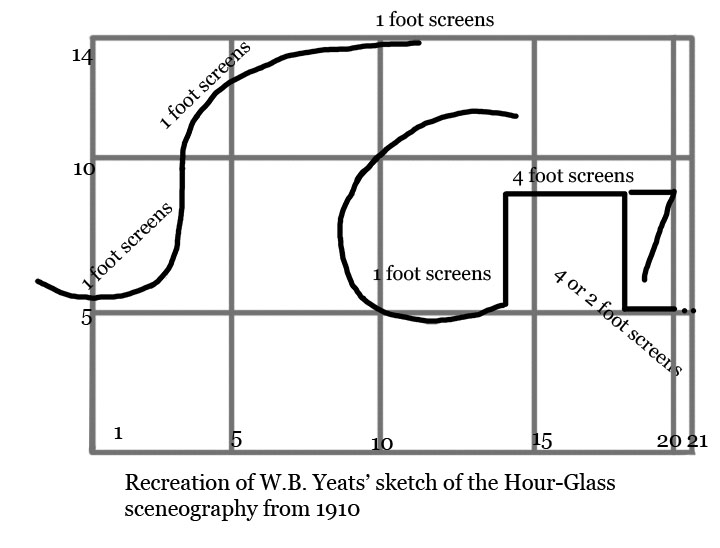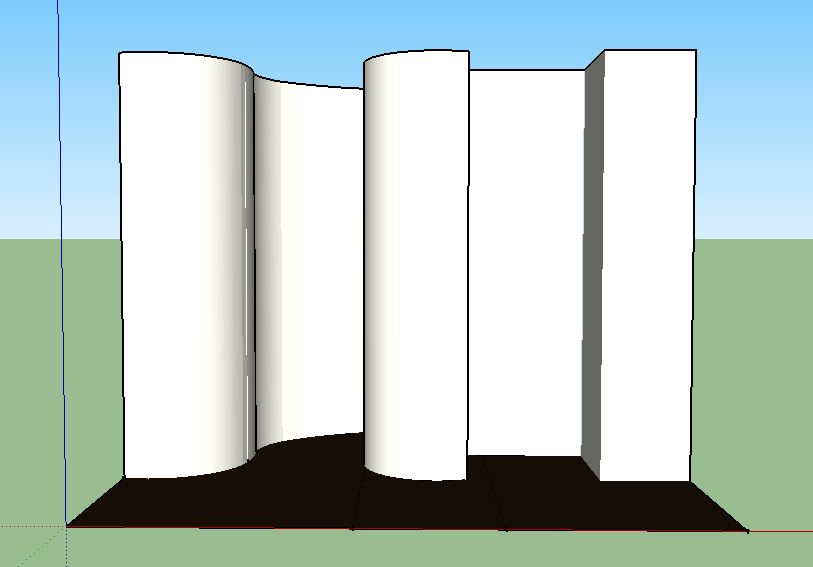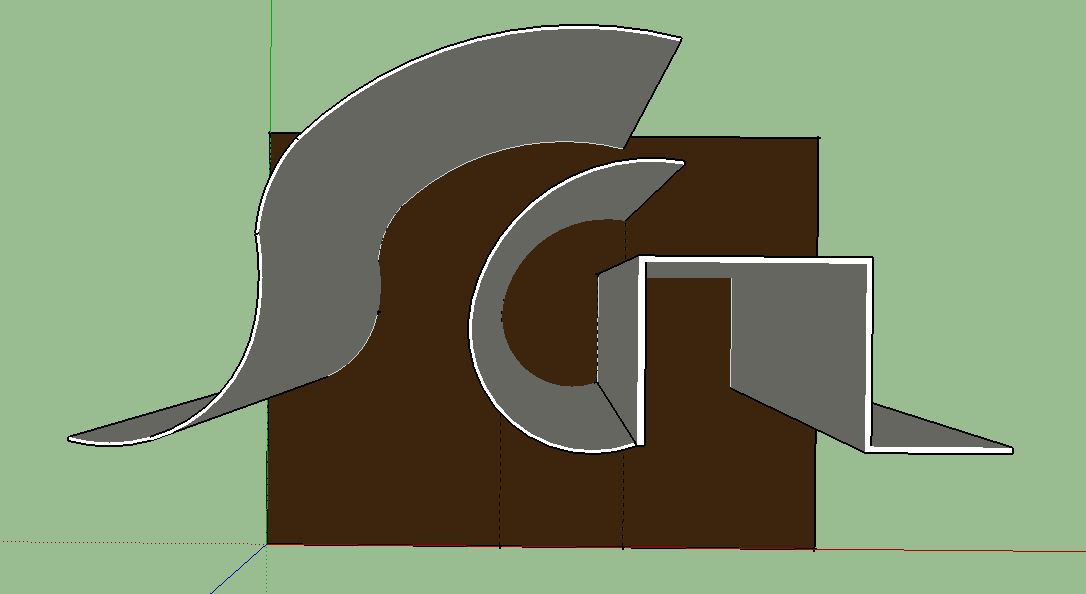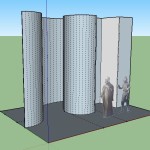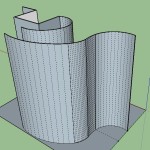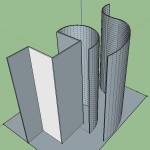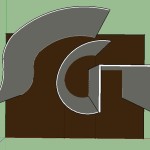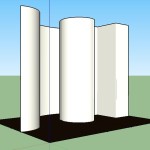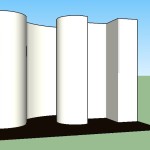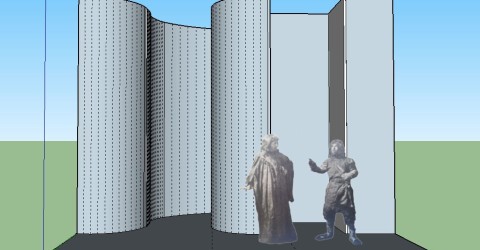
After several weeks planning our project, developing our aims and methods and collecting a corpus of technical and historical background research, it was finally time to get our feet wet with some actual modeling in SketchUp Make 2014. Originally created by Google, SketchUp free to use (a professional version is also available) and is touted by its makers as ‘3D for everyone’ and ‘the easiest way to draw in 3D.’ It offers robust 3D modeling techniques with simplified tools that are more intuitive to use than other industry standards such as AutoCAD and 3D Studio Max (3ds Max). So while architects and other visualization experts use SketchUp to create professional mock-ups of their work, it is easy enough for a novice to competently use for their own visualization projects as well. Using SketchUp to create our visualizations and making them free to download makes it possible for anyone to easily build on our work to further their own research on Craig’s vision of the theatre and this era of stage productions at the Abbey.
For the visualization stage of our project we decided to begin by modelling Craig’s screens for the 1911 production of the Hour-Glass because we found a reproduction of a surviving original 1910 pencil sketch by Yeats in Karen Dorn’s article ‘Dialogue Into Movement: W.B. Yeats’s Theatre Collaboration with Gordon Craig’. It illustrates Yeats’ original stage plan for the 1911 production including the use of Craig’s screens for the play’s stage design. (See the blog post ‘The Hour-Glass & Evidence for our Visualisation’ for more a detailed explanation of our research). The sketch was an obvious choice to model because it was the only original source material we found at this stage in our research which resembled an architectural drawing., which included a floor plan design and reference to the dimensions of the Old Abbey stage (20 feet wide and 15 feet deep, given to us by Hugh Denard, the research director for the Abbey Theatre, 1904 project).
The aim of this initial model was not to create a fully realized and accurate stage design. Rather it was to get an idea of how much time it should take to visualize Craig’s stage designs and create a working model which can be used to test other aspects of the visualization process including textures for the screens and especially lighting, which we rightly hypothesized would be the most challenging aspect of our project.
The Hour-Glass model was created by importing Yeats sketch into SketchUp and enlarging it to a 1:1 foot ratio in the modeling environment. Measurements were taken from the sketch and used to create reference points on a new plane to represent the stage floor rather than modeling directly on top of the sketch itself. The dimensions of this first model are not entirely accurate in relation to the sketch but nevertheless the model successfully demonstrates the vision of Yeats sketch. The sketch below is a recreation of Yeats’ original 1910 sketch.
In order to demonstrate scale and begin visualizing the actor within the screen environment, images of the Wise Man (left) and the Fool (right) were cut out from a postcard advertising the 1905 production of the Hour-Glass at the Abbey and inserted into the model. Since Yeats made significant changes in the visual styling of the play (not to mention the text itself) these images are for demonstration purposes only and are not accurate for the 1911 production.
The screens were then ‘painted’ ivory based on two references to ivory colored screens. Yeats himself remarked, “[…] I have simplified the scenery, having The Hour Glass, for instance, played now before green curtain, now among those admirable ivory-coloured screens invented by Gordon Craig[…]” (see Seskine, p.138). The other reference comes from Richard Taylor who described a, “symbolic and harmonious colour scheme of olive-green, purple and red-brown against the ivory screens designed by Edward Gordon Craig” (Taylor p.18).

Practice visualization of 1912 Hour-Glass production screens painted ivory featuring characters from 1905 Hour-Glass production
Additional Images Unpainted Screens
- Stage front view of unpainted screens for the 1913 Hour-Glass production with characters from the 1905 production.
- Original practice model shown in SketchUp with original Yeats 1910 sketch used to create the model.
- Stage right view of unpainted screens with 1905 Hour-Glass characters.
- Stage left view of unpainted screens with characters from 1905 Hour-Glass production.
- Stage right back view
- Back view
- Stage left back view
Ivory Screens
- Front view of screens for the Hour-Glass painted ivory.
- Front view; ivory screens
- Stage left view; ivory screens
- Back view, stage left; ivory screens
- Back view, stage left; ivory screens
- Top view; ivory screens
- Back view; ivory screens
- Back view, ivory screens
- Stage right, back vie; ivory screens
- Stage right; ivory screens
- Stage right; ivory screens
- Stage right; ivory screens
Ivory Screens with 1905 Hour-Glass Characters
- Ivory screens with 1905 characters
- Stage right view
- Stage right view
- Stage left view
Bibliography
- Dorn, Karen. ‘Dialogue Into Movement: W.B. Yeats’s Theatre Collaboration with Gordon Craig’. Yeats and the Theatre. Ed. O’Driscoll, Robert and Reynolds, Lorna. London [etc.]: Macmillan, 1975. 109–137. Print.
- Postcard [Clare’s source from archive]
- Seskine, Masaru. ‘Noh and Yeats: A Theoretical Analysis’. Ariel 26.4 (1995): n. pag. Print.
- Taylor, Richard. The Drama of W.B. Yeats: Irish Myth and the Japanese Nó. New Haven ; London: Yale U.P, 1977. Print.

